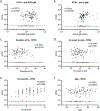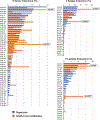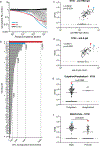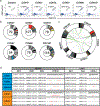Convergent antibody responses to SARS-CoV-2 in convalescent individuals
- PMID: 32555388
- PMCID: PMC7442695
- DOI: 10.1038/s41586-020-2456-9
Convergent antibody responses to SARS-CoV-2 in convalescent individuals
Abstract
During the coronavirus disease-2019 (COVID-19) pandemic, severe acute respiratory syndrome-related coronavirus-2 (SARS-CoV-2) has led to the infection of millions of people and has claimed hundreds of thousands of lives. The entry of the virus into cells depends on the receptor-binding domain (RBD) of the spike (S) protein of SARS-CoV-2. Although there is currently no vaccine, it is likely that antibodies will be essential for protection. However, little is known about the human antibody response to SARS-CoV-21-5. Here we report on 149 COVID-19-convalescent individuals. Plasma samples collected an average of 39 days after the onset of symptoms had variable half-maximal pseudovirus neutralizing titres; titres were less than 50 in 33% of samples, below 1,000 in 79% of samples and only 1% of samples had titres above 5,000. Antibody sequencing revealed the expansion of clones of RBD-specific memory B cells that expressed closely related antibodies in different individuals. Despite low plasma titres, antibodies to three distinct epitopes on the RBD neutralized the virus with half-maximal inhibitory concentrations (IC50 values) as low as 2 ng ml-1. In conclusion, most convalescent plasma samples obtained from individuals who recover from COVID-19 do not contain high levels of neutralizing activity. Nevertheless, rare but recurring RBD-specific antibodies with potent antiviral activity were found in all individuals tested, suggesting that a vaccine designed to elicit such antibodies could be broadly effective.
Figures














Update of
-
Convergent Antibody Responses to SARS-CoV-2 Infection in Convalescent Individuals.bioRxiv [Preprint]. 2020 May 22:2020.05.13.092619. doi: 10.1101/2020.05.13.092619. bioRxiv. 2020. Update in: Nature. 2020 Aug;584(7821):437-442. doi: 10.1038/s41586-020-2456-9. PMID: 32511384 Free PMC article. Updated. Preprint.
Similar articles
-
Potent neutralizing antibodies against multiple epitopes on SARS-CoV-2 spike.Nature. 2020 Aug;584(7821):450-456. doi: 10.1038/s41586-020-2571-7. Epub 2020 Jul 22. Nature. 2020. PMID: 32698192
-
A vaccine targeting the RBD of the S protein of SARS-CoV-2 induces protective immunity.Nature. 2020 Oct;586(7830):572-577. doi: 10.1038/s41586-020-2599-8. Epub 2020 Jul 29. Nature. 2020. PMID: 32726802
-
SARS-CoV-2 spike produced in insect cells elicits high neutralization titres in non-human primates.Emerg Microbes Infect. 2020 Dec;9(1):2076-2090. doi: 10.1080/22221751.2020.1821583. Emerg Microbes Infect. 2020. PMID: 32897177 Free PMC article.
-
Targeting SARS-CoV2 Spike Protein Receptor Binding Domain by Therapeutic Antibodies.Biomed Pharmacother. 2020 Oct;130:110559. doi: 10.1016/j.biopha.2020.110559. Epub 2020 Aug 1. Biomed Pharmacother. 2020. PMID: 32768882 Free PMC article. Review.
-
The SARS-CoV-2 Spike Glycoprotein as a Drug and Vaccine Target: Structural Insights into Its Complexes with ACE2 and Antibodies.Cells. 2020 Oct 22;9(11):2343. doi: 10.3390/cells9112343. Cells. 2020. PMID: 33105869 Free PMC article. Review.
Cited by
-
The molecular mechanisms of CD8+ T cell responses to SARS-CoV-2 infection mediated by TCR-pMHC interactions.Front Immunol. 2024 Oct 10;15:1468456. doi: 10.3389/fimmu.2024.1468456. eCollection 2024. Front Immunol. 2024. PMID: 39450171 Free PMC article. Review.
-
Monoclonal antibodies: From magic bullet to precision weapon.Mol Biomed. 2024 Oct 11;5(1):47. doi: 10.1186/s43556-024-00210-1. Mol Biomed. 2024. PMID: 39390211 Free PMC article. Review.
-
Full-length single-cell BCR sequencing paired with RNA sequencing reveals convergent responses to pneumococcal vaccination.Commun Biol. 2024 Sep 28;7(1):1208. doi: 10.1038/s42003-024-06823-0. Commun Biol. 2024. PMID: 39341987 Free PMC article.
-
Design, Immunogenicity and Preclinical Efficacy of the ChAdOx1.COVconsv12 Pan-Sarbecovirus T-Cell Vaccine.Vaccines (Basel). 2024 Aug 26;12(9):965. doi: 10.3390/vaccines12090965. Vaccines (Basel). 2024. PMID: 39339997 Free PMC article.
-
Rapid affinity optimization of an anti-TREM2 clinical lead antibody by cross-lineage immune repertoire mining.Nat Commun. 2024 Sep 27;15(1):8382. doi: 10.1038/s41467-024-52442-y. Nat Commun. 2024. PMID: 39333507 Free PMC article.
References
Publication types
MeSH terms
Substances
Grants and funding
LinkOut - more resources
Full Text Sources
Other Literature Sources
Miscellaneous

